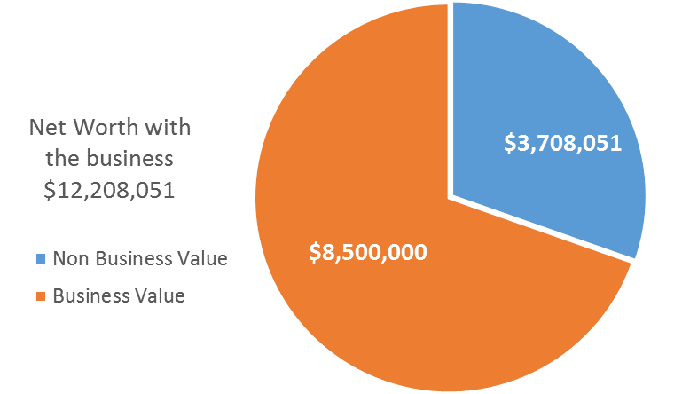Exit Planning as a Strategic Business Tool
Focus on Value Management
In this article, the author discusses the importance of using business value as the baseline driver of business performance and how we use it as a measurement of success.
[su_pullquote align=”right”]Resources:
Certified Exit Planning Advisor (CEPA) Credentialing Program
Unlocking Client Value, Unleashing Firm Growth—The Opportunity for Value Growth Services
The CPAs Role in the Exit Planning Process for Middle Market Business Owners
Exit Option Analysis: Helping Your Clients Understand and Evaluate Ownership Transition Options
[/su_pullquote]
QuickReadBuzz readers appreciate the importance of personal planning and the value of assisting business owners envision life after they leave their business. The research conducted by The Exit Planning Institute consistently shows that personal planning does impact business value.
In this article, we will discuss the importance of using business value as the baseline driver of business performance and how we use it as a measurement of success.
- Importance of focusing on business value and making business value management your number one goal
- Why value growth strategies increase sales and income as well as business value
- How to use value growth strategies as a strategic business tool
- The difference between attractiveness and readiness, learn how to measure this, and how attractiveness and readiness are used to measure business value and value gains
- Understand the formula to determine value
- Review a case study
Introduction
Focusing on value sounds like a subtle play on words but in reality, this is a major paradigm shift. The number one goal of the owner should be to focus on value management; even more important than people. People are part of value management. Value management is about increasing the transferable value of intangible assets (human, customer, structural, and social). You can have value and income but only if you focus on value first. Income alone does not necessarily mean the business has “value.”
Lifestyle or Value Creator?
Over my 35 years, I have worked with dozens of public and privately held businesses and I can put them in two categories: lifestyle businesses and value creator businesses. Both types of businesses can generate strong income. But only a value creator business has a chance to sell or transition successfully. And, I would argue that their financial performance, including the income they generate, is in the premier and best-in-class arena.
Ninety percent of all businesses are lifestyle businesses. Many are generating a nice income for the shareholders but they will never be able to sell or transition successfully unless they get lucky, which some do. The reason is that these lifestyle businesses, although generating a nice income, do not have transferrable intangible assets. They are dependent on the owner and when the owner goes, the business goes with him or her. These owners own the customer relationships (customer capital) and they often are the drivers of outcomes in the business. Their staff (human capital) cannot manage, let alone grow, without the leadership of the owner. The processes and systems (structural capital) they use to generate outcomes are not documented in such a form that they are packaged and transferrable. And, these shortcomings likely mean that they lack a culture of relentless execution (social capital).
Value creator businesses are the opposite. What do value creators do?
- Recognize exiting is part of the business lifecycle
- Focus on value first. Value is always top of mind
- Recognize that 80% of value lies in intangible assets
- Take a systematic approach to identifying, protecting, building, harvesting, and managing value
- Chip away, relentlessly executing, 90 days at a time
- Their business is owner independent
- View value growth as an investment vs. expense and budget for it
- The business is not their only focus—their personal, financial, and business objectives are in harmony
Only about 10% of all businesses are positioned this way—as value creators. That is a big reason why transition success rates are only in the range of 20–30%. Some do get lucky.
Why is This Important?
Let’s look at an actual owner’s wealth portfolio without the business (see below).
This owner had a net worth of $3.7 million without the business included. Most of this was tied to retirement plans and real estate. At best, if this owner retired now, he would have $3.7 million to work with. Assuming he could get an aggressive return of six percent before taxes on all these assets, this owner would have an ongoing income stream before taxes of $222,000 upon exit.
This business was producing about two million dollars in recasted EBITDA, meaning that if the owner were not able to sell his business, he would be looking at a 90% pay cut—ouch!
Including the business in the wealth plan adds $8.5 million to the portfolio, bringing the total value of the portfolio to $12.2 million; a 230% increase in wealth.
As you can easily see, 70% of his wealth is tied to business value. This is not uncommon. Most financial planners estimate that the business value is usually 80% or more of the total net worth of the owner. We would need to subtract fees, taxes, and such to determine the owners’ net proceeds from a sale. But to keep it simple, let’s just say the owner can harvest the entire $8.5 million and put it to work. Using the same aggressive six percent, the owner’s ongoing income stream before taxes would grow to $732,000 (a $510,000 increase annually).
Going from two million dollars a year to $732,000 is still a pretty sizable pay cut. But it is a lot better than $222,000 if the owner were not able to harvest the wealth in the business, that is for sure.
Now, do you think having the ability to harvest the wealth trapped in the business will make a difference to the owner’s lifestyle, the owner’s family, and legacy, post business?  You better believe it. And, if we look at this over 10 years, we are talking about a difference of $7.32 million of income vs. $2.22 million—double ouch!
The Case of CWR
Not too long ago, I assessed a company that was doing $33.4 million in sales—not too shabby. We will call that company CWR. CWR was on a nice run. Sales had increased from $21.8 million to $33.4 million over the past three years equaling a compound annual growth rate (CAGR) of 15%. CWR’s EBITDA was on an even bigger roll moving from $1.2 million to $2.5 million (CAGR 27%) during the same period. Impressive.
CWR was financially performing below industry standards at 7.5% EBITDA to sales. Yet it was still producing good income.
Does CWR have any value?
After completing an Attractiveness and Readiness Assessment with the owner and the financial analysis, the owner asked me, “Well, what do think the value is?”  I explained I needed time to evaluate the interview results. But he kept pressing me. “I know Chris,” he said, “but you look at these all the time; what does your gut tell you?”
“Nothing,” I said. After a short pause to let it sink in I added, “We might be able to sell your customer list for pennies on the dollar.”
Well, he practically turned white before turning red with anger. “How can that be?” he shouted, now questioning my ability. Let’s face it. I did want to shock him. “Well, let’s look at it.”  I began a summary of his attractiveness and readiness:
There are some things that make the business attractive:
- Customer loyalty (tenure)
- Staff longevity
- Growth: sales and profit
- Competitive positioning (low cost)
- Low risk
- Good set of financial documentation
“However,” I said, “there are a significant number of factors that are real weaknesses and, in my opinion, deal killers that make the business very unattractive:”
Owner Dependency (Deal killer)
- Low barriers to entry
- Business systems and processes not documented (meaning not transferrable)
- Packaged IP and technology lacking
- No brand awareness
- Low recurring revenue model
- Market is flat (not growing)
- Non-dominating position in the market
- Low synergies to strategic buyer
Customer Concentration (Deal killer)
“In addition, the business is not ready to transition and neither are you personally,” I said. I listed the following business readiness issues:
- No written business transition strategy
- No strategic plan (past, current, future)
- No testimonials, awards, community recognition
- No key customer analytics to share
- Marketing not systematized
- No HR strategy, development, or succession program
- Employee documentation weak
- No formal contracts: customer or supplier
- Business systems not documented
- No expense analytics
- No financial forecast or support for history
- No historical dashboards
And, I listed the following personal readiness issues:
- No written personal strategy
- Financial needs vs. wants analysis not determined
- No contingency plan
- No personal financial plan
- No estate plan
- No tax minimization plan
After listing these off, I looked at him and asked, “What would a buyer be buying?”
I reminded him of the previous discussions we had about the difference between lifestyle and value creator businesses and the difference between attractiveness and readiness.
Attractiveness is how a business looks from a buyer’s point of view, from the outside in. Readiness is a measure of how ready the business and the owner are to transition or transfer that asset to a future owner. A business may look attractive. It may even be producing nice income. But that does not mean it is ready to transition/transfer. And further, that does not mean that the owner is ready to transition/transform. There is a big difference. “You are not ready and neither is the business,” I said.
“If we were to take you to market now, it is unlikely we would ever get a deal done once the buyer was able to look under the hood and find that your intangible assets are not structured (structural capital) to transfer. Nothing is documented. There is no brand (social capital), no analytics, no strategy, and no proof. The business cannot run without you (human capital). The key customer relationships (customer capital), although generating good sales and income right now, are concentrated and all based on the personal relationships you have with the customers. The buyer may make you an offer based on attractiveness, but once they see how unprepared the business is to transfer and analyze the risks to the future streams of income, they will likely modify the terms in their favor, not yours, and distribute much of the risk to you, and there is a good chance they will just walk away. It is too risky. Do you realize how disruptive and expensive that would be?  Even if they decide to move ahead, given the risks, they will likely offer pennies on the dollar and require you to stay in and take a big contingency.”
I further explained that I felt that it was unlikely he would be able to sustain the strong growth over the last three years—the business model was not scalable for all the same reasons. He had been under investing to build profits. “At some point, you are going to hit a wall. How much can one person do?” I asked. “And if you lose one of those big customers, you will take a major hit,” I added. “What if your key contact at one of these customers leaves?  Or you get sick and cannot service them anymore,” I asked. “You have no contingency in place and your people are not ready to step up because you have not trained them, nor have systems in place to ensure the business can keep going on its own. You admitted to me you are the best sales person in the company and maybe there might be one other reasonably decent sales person other than you that can sell.”
After the shock wore off, we continued talking. I said to him, “You should be very proud of what you have accomplished. The business is growing and EBITDA is growing even faster. These big companies obviously see value in what you are providing. I actually think you have a secret sauce here. I think there is a brand in there somewhere that we could take to market and leverage. I think there are processes and systems you use; you just have not documented how you do what you do that makes this business so special, why it has grown the way it has, and trained up your people to perform at the level you perform without you. Making the business independent of you, transferring those relationships to the company (vs. you), and getting people to follow your processes, would not only make the business way more valuable, but it will free you up to focus on expanding and keeping it growing while mitigating the risk so you can start sleeping again at night instead of worrying.”
So, I asked, “do you see how focusing on value will also drive more income and sales?”  If the owner of CWR had more time, he would likely see the following results:
- Better sales performance less dependent on owner
- Broader brand which is not reliant on owner’s relationships
- Ability to further scale while working to improve margins and keep expenses under control
- Time to recruit, evolve people, grow new accounts, expand markets/products/lines of business, build brand, etc.—things the owner should be working on
- Resulting in improved attractiveness and readiness scores which will raise the business value in the range of value
This is how exit planning should be viewed: as a strategic business tool to drive company behavior. Focusing on value drives all other positive outcomes. Value acceleration, in particular, focuses on improving intangible assets: human, customer, structural, and social. These four capitals (the 4Cs) drive business performance while positioning the owner to harvest when that day comes, on his or her timeline or not.
The Triggering Event
The first step to determine your business value is to complete a personal, financial, and business assessment and correlate these scores to the range of value in your industry and for similar size companies. There is no way for you to know your value factually and to have any basis/support unless you complete an Attractiveness and Readiness Assessment. Not only will you know and have support for your present value, but perhaps even more importantly, you will also learn how much money you may be leaving on the table by knowing your potential value. I call this the profit gap and the value gap.
Once you understand the strengths and weaknesses from an attractiveness and readiness standpoint, you can get to work on improving those factors. These “value” factors not only determine the likelihood of selling your business, but also identify the likelihood of succeeding with growth or succeeding with a generational, management, employee transition. A business that is not ready to transition is not ready to grow.
In CEPA circles, we call this process “the triggering event” because the information is so compelling that business owners change behavior and go going forward with value growth actions 70% of the time. The triggering event accomplishes five important things:
- Establishes, based on fact, your present value
- Predicts the probability of succeeding with growth and transition strategies
- Identifies your profit gap
- Identifies your value gap
- Identifies actions you can take to protect, build, and harvest value
After completing the triggering event, you will have a slew of value growth actions that you can implement to grow value. In future articles, I will discuss how you sort through them to determine which ones to do first, second, and third. And, in future articles, we will discuss how to empower your team, how to measure progress, and the impact implementing these actions is having on business value.
- Action: Your action is to consider getting a triggering event completed with your local CEPA. I urge you to get this done now. Identifying value is the first step in the 5 Stages of Value Maturity. It is always first and should never be skipped. You will get tremendously more value from the 11 Actions an Owner Must Take to Rapidly Grow Value & Unlock Wealth if you have this completed as we move through the rest of the series. Feel free to call my office or send an e-mail if you need a recommendation.
Much of what has been written about exit planning focuses on the endgame. Exit planning is not accomplished by focusing on endgame. Successful exits are based on what you do every day. You can have more sales and income today and position yourself to harvest the wealth in your business in the future (or pull a dividend). But you need to focus on value first.
Change the outcome!
Chris Snider, CEPA, is the award-winning author of Walking to Destiny: 11 Actions an Owner Must Take to Rapidly Grow Value & Unlock Wealth, a business strategy book about the Value Acceleration Methodology™ written for business owners and the advisors who serve them. Mr. Snider is a professional keynote speaker and content provider to the middle market business community, trade and industry associations, and professional education organizations. For his written work and his contributions to the industry, he has been awarded recent honors that include 2016 NACVA Industry Titan Architect and 2016 AM&AA Thought Leader of the Year. Mr. Snider is the managing partner of Snider Premier Growth, the CEO/President of Exit Planning Institute, the Founder of ThinkTank Publishing House, and the contributing author of SniderValueIndex.com. For further information visit www.snidervalueindex.com and www.exit-planning-institute.org.
Mr. Snider can be contacted at (216) 712-4244 or by e-mail to CSnider@Exit-Planning-Institute.org.












